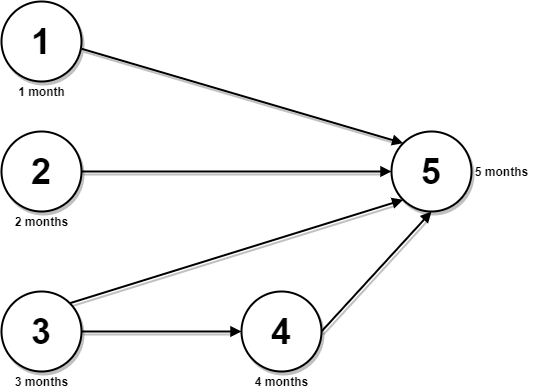You are given an integer n, which indicates that there are n courses labeled from 1 to n. You are also given a 2D integer array relations where relations[j] = [prevCoursej, nextCoursej] denotes that course prevCoursej has to be completed before course nextCoursej (prerequisite relationship). Furthermore, you are given a 0-indexed integer array time where time[i] denotes how many months it takes to complete the (i+1)th course.
You must find the minimum number of months needed to complete all the courses following these rules:
- You may start taking a course at any time if the prerequisites are met.
- Any number of courses can be taken at the same time.
Return the minimum number of months needed to complete all the courses.
Note: The test cases are generated such that it is possible to complete every course (i.e., the graph is a directed acyclic graph).
Example 1:

Input: n = 3, relations = [[1,3],[2,3]], time = [3,2,5] Output: 8 Explanation: The figure above represents the given graph and the time required to complete each course. We start course 1 and course 2 simultaneously at month 0. Course 1 takes 3 months and course 2 takes 2 months to complete respectively. Thus, the earliest time we can start course 3 is at month 3, and the total time required is 3 + 5 = 8 months.
Example 2:

Input: n = 5, relations = [[1,5],[2,5],[3,5],[3,4],[4,5]], time = [1,2,3,4,5] Output: 12 Explanation: The figure above represents the given graph and the time required to complete each course. You can start courses 1, 2, and 3 at month 0. You can complete them after 1, 2, and 3 months respectively. Course 4 can be taken only after course 3 is completed, i.e., after 3 months. It is completed after 3 + 4 = 7 months. Course 5 can be taken only after courses 1, 2, 3, and 4 have been completed, i.e., after max(1,2,3,7) = 7 months. Thus, the minimum time needed to complete all the courses is 7 + 5 = 12 months.
Constraints:
1 <= n <= 5 * 1040 <= relations.length <= min(n * (n - 1) / 2, 5 * 104)relations[j].length == 21 <= prevCoursej, nextCoursej <= nprevCoursej != nextCoursej- All the pairs
[prevCoursej, nextCoursej]are unique. time.length == n1 <= time[i] <= 104- The given graph is a directed acyclic graph.
Similar Questions:
- Course Schedule III (Hard)
- Parallel Courses (Medium)
- Single-Threaded CPU (Medium)
- Process Tasks Using Servers (Medium)
A node's distance is its time plus the maximum distance of all predecessor nodes. We can calculate the distances via a topological sort. The answer is the maximum distance.
// OJ: https://leetcode.com/problems/parallel-courses-iii/
// Author: github.com/lzl124631x
// Time: O(N + E)
// Space: O(N + E)
class Solution {
public:
int minimumTime(int n, vector<vector<int>>& E, vector<int>& T) {
vector<vector<int>> G(n);
vector<int> indegree(n), dist(n);
for (auto &e : E) { // build graph and count indegrees
G[e[0] - 1].push_back(e[1] - 1);
indegree[e[1] - 1]++;
}
queue<int> q;
for (int i = 0; i < n; ++i) {
if (indegree[i] == 0) { // enqueue nodes with 0 indegree.
q.push(i);
dist[i] = T[i]; // source nodes' distance is their corresponding time
}
}
while (q.size()) {
int u = q.front();
q.pop();
for (int v : G[u]) {
dist[v] = max(dist[u] + T[v], dist[v]); // update the distance of node `v` using the maximum distance of predecessor nodes.
if (--indegree[v] == 0) q.push(v); // enqueue node `v` when its indegree drops to 0
}
}
return *max_element(begin(dist), end(dist)); // the answer is the maximum distance.
}
};DFS version topological sort is Post-order Traversal + Memo.
// OJ: https://leetcode.com/problems/parallel-courses-iii/
// Author: github.com/lzl124631x
// Time: O(N + E)
// Space: O(N + E)
class Solution {
public:
int minimumTime(int n, vector<vector<int>>& E, vector<int>& T) {
vector<vector<int>> G(n);
vector<int> dist(n);
for (auto &e : E) G[e[1] - 1].push_back(e[0] - 1);
function<int(int)> dfs = [&](int u) {
if (dist[u]) return dist[u];
int mx = 0;
for (int v : G[u]) mx = max(mx, dfs(v));
return dist[u] = mx + T[u];
};
for (int i = 0; i < n; ++i) dfs(i);
return *max_element(begin(dist), end(dist));
}
};https://leetcode.com/problems/parallel-courses-iii/discuss/1537501/C%2B%2B-Topological-Sort